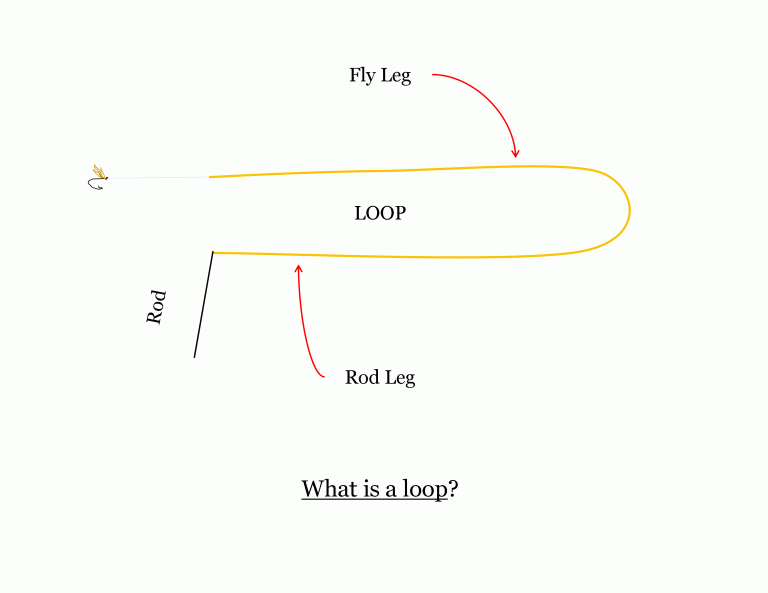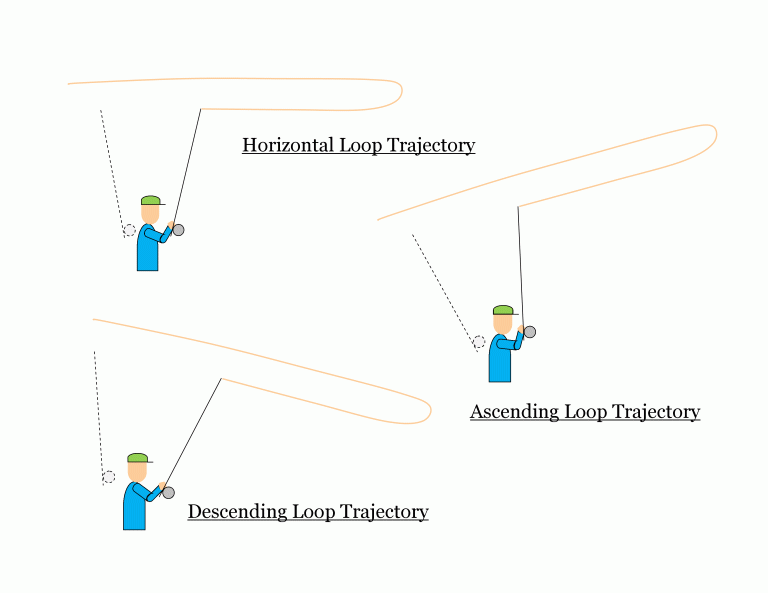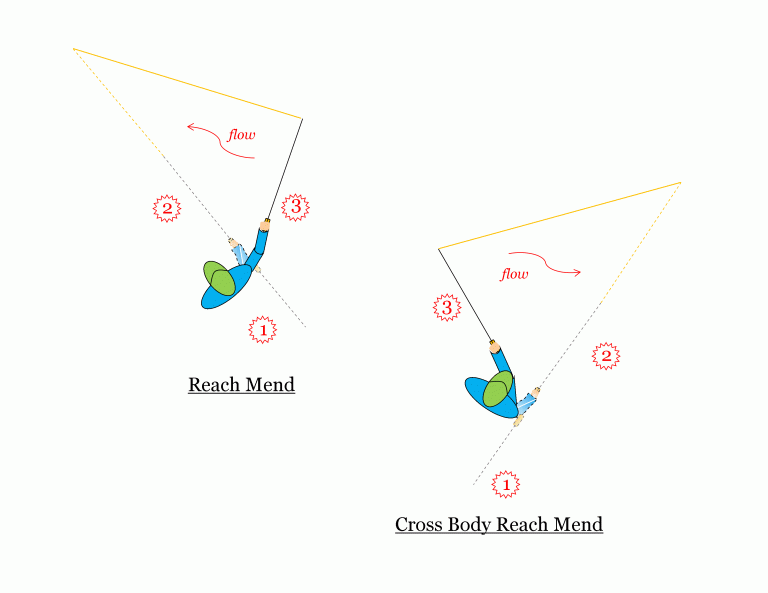I previously wrote about the Five Essentials of Fly Casting. Over the last few years, I’ve spent countless hours working with our casting group in Warren, PA. In that time, we primarily practiced the Fundamentals of Casting, constructively critiqued one another, and worked on teaching casting to others. Learning and practicing the Five Essentials should be the first steps as a Fly Caster. Once you have a solid grasp on the fundamentals, you can begin to understand the next group of fly casting skills. Skills our fearless leader and Fly Fishers International Master Casting Instructor, Gary Kell refers to as Five Variables. While maintaining the Five Essentials, these Five Variables are practical changes we can make to our basic cast to create Fishing Casts. The Five Variables are:
- Loop Size
- Loop Speed
- Loop Plane
- Loop Trajectory
- Rod Mends
Loop Size
The Loop is the “U” shape created by our fly line outside of our rod tip. As we make a cast, the line forms two “legs,” the Rod Leg and the Fly Leg. We generally refer to the size of loop size as narrow (3 ft wide or less), medium (3 to 6 ft wide), and wide (6 to 8 ft wide or more), referring to the distance between the rod leg and fly leg.
We generally refer to the size of loop size as narrow (3 ft wide or less), medium (3 to 6 ft wide), and wide (6 to 8 ft wide or more), referring to the distance between the rod leg and fly leg. Narrow loops are the most efficient loops and are critical for casting in the wind, around obstacles, and casting for distance. As a fisherman however, medium and wide loops can be essential in the proper situations. When casting indicators and split shot or heavy sinking lines, gravity becomes the enemy of tight loops. The added weight can cause the fly leg to collapse and create infuriating tangles. I know well from past experience.
Narrow loops are the most efficient loops and are critical for casting in the wind, around obstacles, and casting for distance. As a fisherman however, medium and wide loops can be essential in the proper situations. When casting indicators and split shot or heavy sinking lines, gravity becomes the enemy of tight loops. The added weight can cause the fly leg to collapse and create infuriating tangles. I know well from past experience.
We can increase our loop size by increasing our casting arc for a particular length of line. This increase in casting arc creates the convex rod tip path (more circular) mentioned in the Five Essentials.
Beware, the shorter we can make our casting stroke for a length of line, the narrower our loops will be, to a point. If we use too short of a casting stroke for a length of line, we will end up with a tailing loop resulting in knots and tangles.
Loop Speed
We can vary our loop speed from slow, to moderate, to fast. Moderate would be considered a comfortable casting speed. Slower loops take less energy and can be helpful for more delicate presentations whereas, faster loops take more energy but can be helpful in windy conditions, to deliver a fly to a moving fish, or while your boat is moving quickly past your target.
An important thing to remember when varying loop speeds, the more force you apply to the rod, the more it bends the rod. Therefore, in order to maintain our loop shape, we have to make a few adjustments. If we cast faster loops, the more the rod bends, requiring a longer casting stroke and shorter pause. If we cast slower loops, the less the rod bends, requiring a shorter casting stroke and longer pause.
| Varying Loop Speed | ||||
| Slow | Fast | |||
| Force | Less | Force | More | |
| Casting Arc | Shorter | Casting Arc | Wider | |
| Pause | Longer | Pause | Shorter | |
Loop Plane
Our fundamental cast is typically made with a vertical loop plane. There are occasions where we need to change the plane in which our rod travels and, in turn, the plane our loops form. These casts are commonly referred to as a side-arm cast or a cross body cast. We can use these fishing casts when we encounter obstructions or when wind becomes a safety concern (for you or your pals). If we form our loops on the down-wind side of ourselves we can execute a safer cast. Safer, because the wind carries the loop and fly away from us instead of blowing them into us.
If you fail to execute a safe cast, here is a link for a video on how to safely remove a hook from skin. (It works. Yet again, I speak from past experience.) In these situations, our Five Fundamentals remain important. We want our rod tip to follow a straight line path. However, we tip the entire casting arc on its side. When we do this, gravity can again become our nemesis and drag our loops down. A good idea when casting on a horizontal plane is to increase our loop speed to avoid having your fly ticking the grass or slashing the water surface.
In these situations, our Five Fundamentals remain important. We want our rod tip to follow a straight line path. However, we tip the entire casting arc on its side. When we do this, gravity can again become our nemesis and drag our loops down. A good idea when casting on a horizontal plane is to increase our loop speed to avoid having your fly ticking the grass or slashing the water surface.
Loop Trajectory
Generally speaking, we cast our loops with horizontal trajectory, straight back and straight forward. We can vary the trajectory of our loops depending on the fishing situation. It is important to note, we need to maintain loops that are 180º from one another. If we cast upward in the front, our backcast needs to be tilted downward. If we cast downward in the front, our backcast needs to be titled upward.
When we are casting for accuracy, we want to cast with a downward trajectory toward our target. This eliminates the chance the wind can blow our line and fly off target. If we have overhead branches behind us we need to cast downward underneath them, and as a result, our forward cast must have an upward trajectory.
Trajectory of our loops is varied when we stop higher or lower on our casting stroke. For an upward trajectory, stop the rod higher in an ascending manner. To direct our cast downward, stop the rod lower in a descending path.

Rod Mends
The most important thing to remember with rod mends is that the fly line will follow the tip of the rod. Once we have stopped on our forward cast our fly line and fly are going to travel in the direction we’ve just sent it. After we stop, we can use the rod tip to influence what happens between our rod tip and the target.
When we are fishing artificial flies that imitate things that aren’t strong swimmers or are at the mercy of the current (insects, eggs, etc.), it is critical that our offering is free of drag and is floating along freely with the flow. Once the fly is on the water we can mend our flies to achieve a drag free drift. It is, however, much easier to manipulate fly line BEFORE things like current and surface tension start influencing our fly line. As mentioned above, we can manipulate the rod after we stop on our forward cast and our line is still in the air to perform what are referred to as aerial mends.
There are countless ways we can execute aerial mends, but probably the most common is the reach mend. As shown below, we move the rod from location 1 to location 2 in our basic casting stroke. Once we have stopped at location 2, we move the rod to location 3 as the line is traveling toward the target. By changing the angle between the rod tip and the target, we place controlled slack that will be a buffer between our fly and line under tension created from the current. Instead of having a direct connection to our fly and a line under tension, we have bought ourselves a few more seconds of drag free drift without risking pulling our fly under water with an on the water mend.

The Five Variables are essential skills for those interested in using the fly cast as a tool to catch more fish. Once you have a strong foundation built upon the Five Essentials, practice these Five Variables. You’ll be surprised how much more enjoyable time on the water is when you can eliminate tangles and have the tools to catch those extra finicky fish.


Hey Chase ….. really looks good!!
Gary Kell garyffc1@verizon.net 814-706-2506theflyfishingcoach.com
LikeLike
Chase…… hit the wrong key – sent prematurely!! Anyway, thanks for the reference too!! You did a nice job with clear language and some illustrations. etc. I did mine on Powerpoint what did you do?? I have a couple other thoughts …. to make the variables complete and cover all casting situations ???? Sometime we’ll talk more both about the Essentials and the Variables – I keep saying that but …. once we get my school over with and fish the month of May … when we start our casting group,,, I’ll get to it!! and we can do it as a group … learning together!! Gary
Gary Kell garyffc1@verizon.net 814-706-2506theflyfishingcoach.com
LikeLike